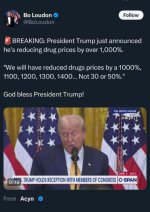dmallord
Humble Hobbit
- Joined
- Jun 15, 2020
- Posts
- 4,678
Your numbers are pretty much sound, as far as they go. However, cherry-picking the positives can shade those that are not doing so well. I picked your friend CHAT.gpt's brain, and it coughed up this for your conversation:How Trump’s Economy Continues To Defy The ‘Experts’ And Shock The ‘Panicans’
For the "experts," the rapid pace of the administration's economic agenda has been shocking. For President Trump, this was all a part of the plan.
By Zach Jewell
•
Jul 21, 2025 DailyWire.com
https://dw-wp-production.imgix.net/2025/07/Donald-Trump-10-scaled-e1753115678636.jpg?ar=16%3A9&auto=compress&crop=faces&cs=origin&fit=crop&w=1035?ar=16:9&fit=crop&crop=faces&fm=webpAFP via Getty Images
In the first six months of President Donald Trump’s second term, one major theme has defined Trump’s economic record thus far: success that surprises the people who are paid to predict it.
It hasn’t been surprising for the president, who is carrying out his promise to revamp American manufacturing and boost American jobs, mainly by imposing unprecedented tariffs on nearly every country in the world. And it comes as economists who predicted large-scale inflation and market downturn over Trump’s bold economic agenda keep seeing economic metrics come across their desks showing the opposite.
Earlier this year, Americans were told to brace their wallets for rising inflation and prepare for a recession caused by Trump’s major tariffs, especially those levied on America’s biggest trading partners, China, Canada, and Mexico. In May, Goldman Sachs analysts said core goods inflation could hit 6.3% by the end of the year while consumer prices would spike 3.7% by early 2026, according to CNN.
The latest numbers on the U.S. economy fly in the face of the naysayers, branded by Trump as “panicans.” Late last week, the U.S. Census Bureau reported that June retail sales were up 0.6% from May and up 3.5% from last year. Food service and drinks sales jumped 6.6% from June 2024. Those numbers were, of course, better than what economists had predicted — a phrase that has become a monthly tradition since Trump stepped back into the White House
More here: https://www.dailywire.com/news/how-...es-to-defy-the-experts-and-shock-the-panicans
MajorRewrite should change her name to Private Revision.
"Before we start declaring the economy bulletproof, let’s ask: whose economy are we talking about—and which parts are being spotlighted.
"Sure, retail sales are ticking up and inflation isn’t exploding. But those are surface-level snapshots that don’t capture deeper stress zones—and they certainly don’t mean everything is rosy.
"Trump’s tariffs have been a mixed bag—launched, delayed, renegotiated. That kind of uncertainty blunts the total impact. Some businesses bought ahead, others rerouted supply chains—so yes, the inflation bump’s been delayed, but not avoided.
"Meanwhile, sectors that don’t make for headlines are getting squeezed:
- Housing: Tariffs (and duties) on Canadian lumber and other building materials are projected to add $10,900–$14,000 to a typical new home’s construction cost. NAHB/Wells Fargo: $10,900 on average San Francisco Chronicle+4Investopedia+4San Antonio Express-News+4.
- Auto prices: The average transaction price for new vehicles in the U.S. is around $48,700–$48,900, and tariffs may be driving prices higher—potentially adding 4–8% to sticker prices, especially for sub‑$30K models Investopedia.
- Steel & copper: Domestic hot-rolled coil prices are up ~16% year-over-year at about $944/ton Yardeni Research. Even though galvanized steel dipped slightly, upstream costs remain elevated, pressuring manufacturers.
- Farmers: Tariffs and retaliatory measures have slashed export demand. While specific dollar figures vary, federally reported delinquency and bankruptcy rates among rural banks are the highest in a decade, signaling serious financial distress.
- Home prices are being inflated before even hitting the market.
- Car buyers are paying nearly $50K—on average—and struggling with tighter credit.
- Manufacturers are facing raw-material increases that erode margins.
- Farmers are spiraling into debt, with whole crops left unharvested in some cases.
It just goes to show that a fuckton of data must be measured to obtain a more realistic view of where the economy is going. More than your cherry-picked data points to.

